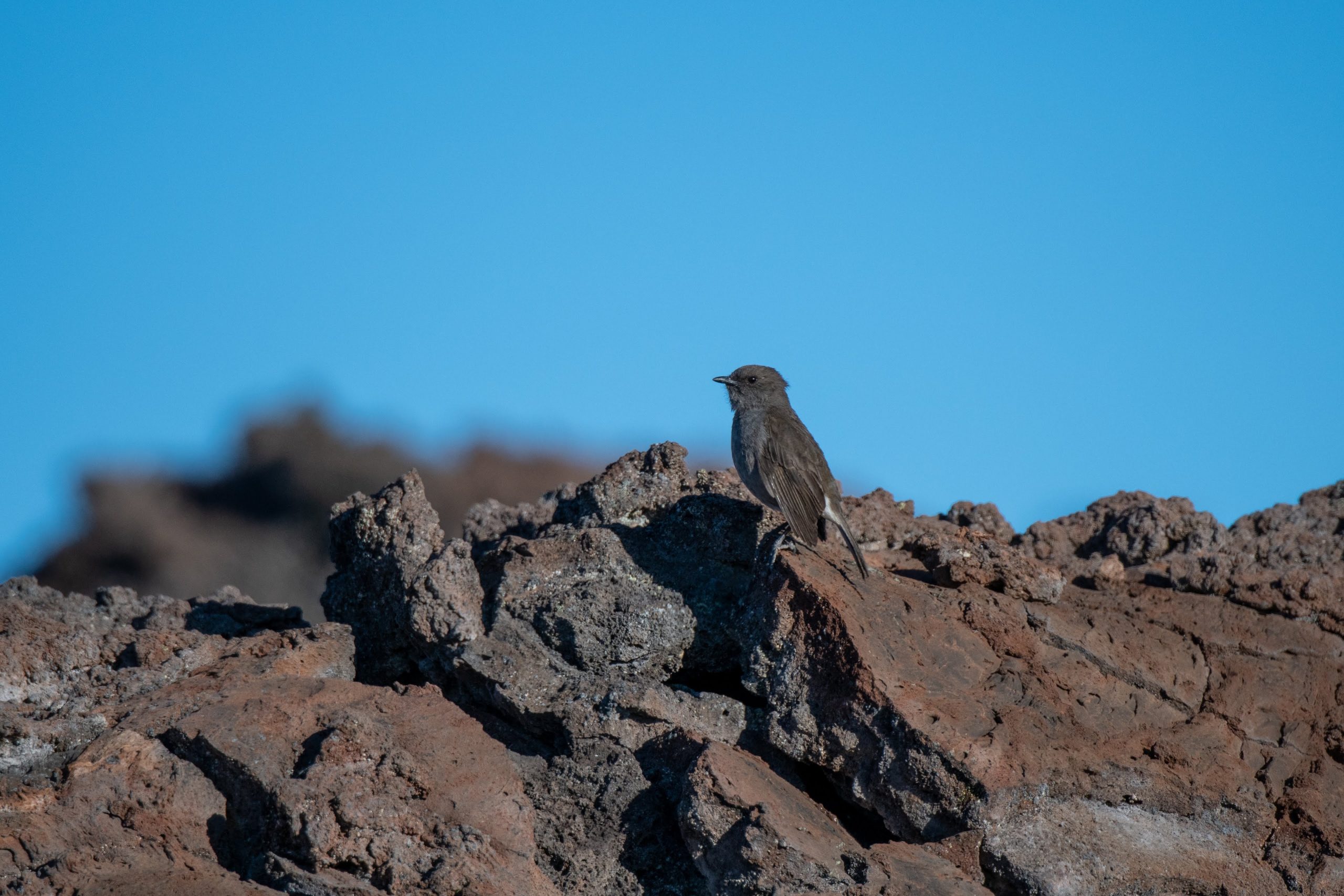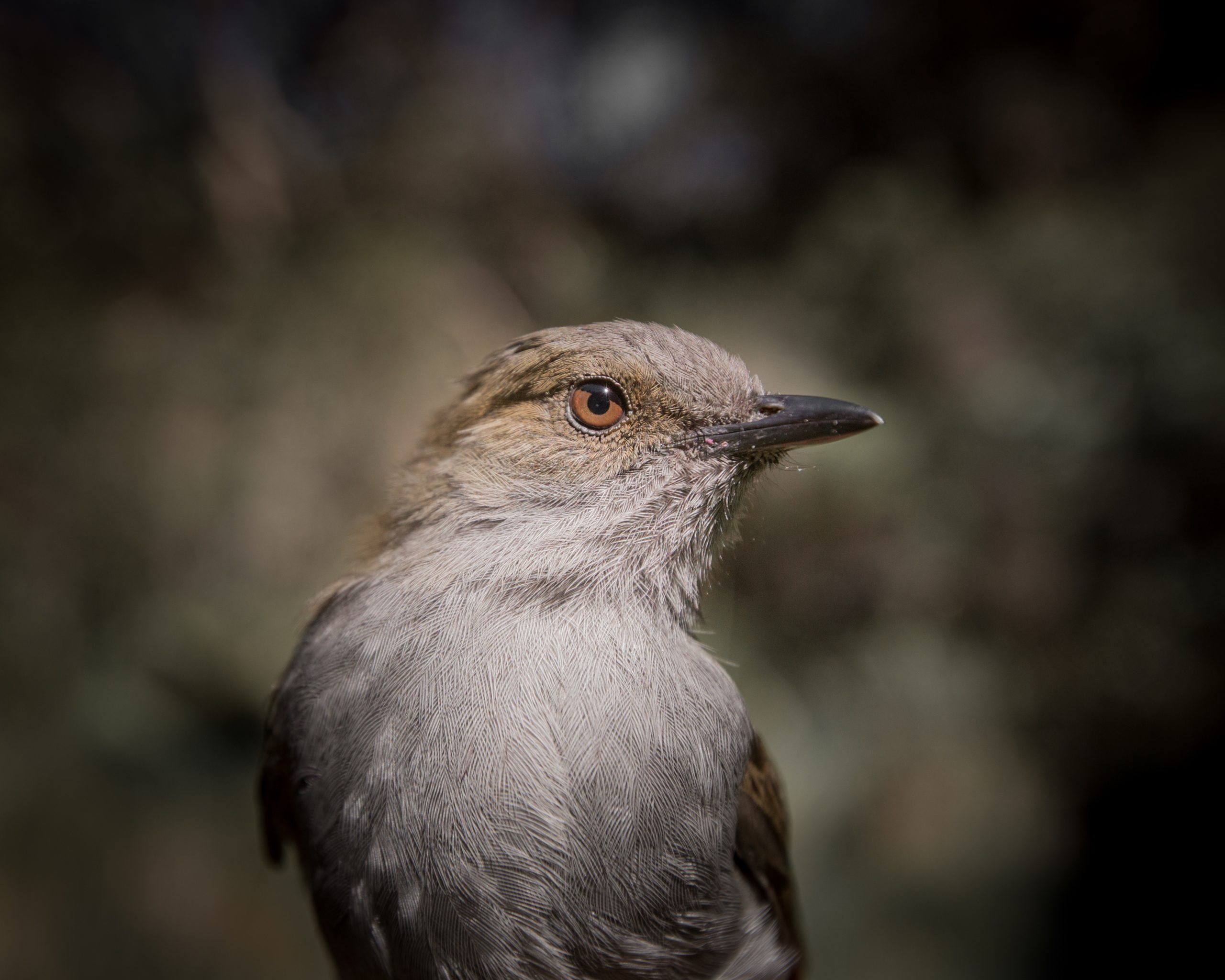‘Ōma‘o
Names
- ʻŌlelo Hawaiʻi: ‘Ōma‘o
- Scientic: Myadestes obscurus
Song
Conservation Status
- State Recognized as Endemic
- NatureServe Heritage Ranking G3—Vulnerable
- IUCN Red List Ranking—Vulnerable
Species Information
One of five species of Hawaiian solitaires (family: Turdidae), the ‘ōma‘o is endemic to the island of Hawai‘i. They often perch silently for long periods and are usually detected by their song; however males perform a flight-song display known as “skylarking.” Like all adult Hawaiian solitaires, ‘ōma‘o have drab olive-brown and gray plumage. Diet consists primarily of fruits of native and introduced understory plant species, although they also take koa (Acacia koa) flowers from the canopy and prey on invertebrates, including earthworms, snails, spiders, and insects. The life history is well-studied. Both sexes defend small nesting territories. Nests are built by females in a variety of locations (e.g., cavities, trunk forks); females also perform most incubation and brooding. They lay one or two eggs, and double sets of offspring can occur. The young remain in natal territories for four to six months after learning how to fly. A male-biased sex-ratio exists (more males than females), but its significance to populations is unknown.
Distribution
Primarily occurs in two populations on the eastern and southern slopes of the island of Hawai‘i at elevations greater than 1,000 meters (3,300 feet). A third, smaller population occurs in alpine scrub between 2,000 and 3,000 meters (6,500 – 9,750 feet). Currently occupies about 30 percent of their former range, which historically included habitats between 300 and 3,000 meters (1,000 – 9,750 feet).
Habitat
Mesic and wet montane ‘ōhi‘a (Metrosideros polymorpha) or mixed ‘ōhi‘a and koa forests in the Hāmākua, Ka‘ū, and Kīlauea districts. These forests support important food plants, including ‘ōlapa (Cheirodendron trigynum), kōlea (Myrsine lessertiana), kāwa‘u (Ilex anomala), naio (Myoporum sandwicense), pilo (Coprosma spp.), pūkiawe (Styphelia tameiameiae), ‘ōhelo (Vaccinium spp.), and ‘ākala (Rubus hawaiiensis). In the small alpine scrub population on Mauna Loa, pūkiawe, ‘ōhelo, kūkaenēnē (Coprosma ernodeoides), and ‘a‘ali‘i (Dodonea viscosa) are important food plants. Although most of the current range occurs on State and federal lands, habitat conditions vary considerably.
Threats
‘Ōma‘o are likely susceptible to the same factors that threaten other native Hawaiian forest birds, including loss and degradation of habitat, predation by introduced mammals, and disease. For ‘ōma‘o, the following are of particular concern:
- Disease. The prevalence of disease in areas tested is low and five ‘ōma‘o exposed to malaria recovered quickly, suggesting a greater disease resistance compared to other native forest birds. However, the species’ disappearance from lower elevations is the pattern of decline noted in other Hawaiian birds susceptible to mosquito-borne diseases.
- Predation. Nests are very accessible and vulnerable to predation by rats (Rattus spp.). Predation by native raptors also is likely.
- Habitat degradation. ‘Ōma‘o occur at lower densities in degraded habitat. Pigs (Sus scrofa) and other ungulates likely destroy important food plants.
Additional Resources
For more information and references visit DLNR State Wildlife Action Plan factsheets. DOFAWʻs species pages and State Wildlife Action Plan fact sheets are provided for general information and are not meant to be a citable, original source of data. If you are a student, researcher, or writer looking for a citable source, please explore the references below or find other original data sources, rather than citing these webpages. The references below were provided by the authors of the State Wildlife Action Plan fact sheets at the time of drafting:
- IUCN Red List of Threatened Species. 2015. Version 2014.3. Available at: www.iucnredlist.org. (Accessed May 2015).
- Scott JM, Mountainspring S, Ramsey FL, Kepler CB. 1986. Forest bird communities of the Hawaiian islands: their dynamics, ecology and conservation. Lawrence, (KS): Cooper Ornithological Society.
- Wakelee KM, Fancy SG. 1999. ‘Oma’o (Myadestes obscurus), kama’o (Myadestes myadestinus), oloma’o (Myadestes lanaiensis), and ‘amaui (Myadestes woahensis). In The Birds of North America, No. 460 (Poole A, Gill F, editors.). Philadelphia, (PA): The Academy of Natural Sciences; and Washington DC: The American Ornithologists’ Union.



